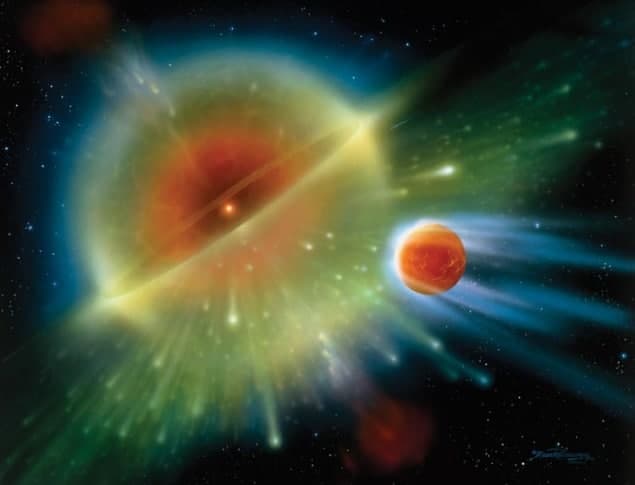How It Ends: From You to the Universe
Chris Impey
2010 W W Norton £18.99/$26.95hb 352pp

As they gaze back in time, their giant telescopes collecting light that has travelled from distant stars and galaxies for millions or even billions of years, astronomers can sometimes seem fixated with the past. Chris Impey is different. Although the University of Arizona astronomer acknowledges that “science mostly answers the question of how things got the way they are”, in his latest book he is chiefly interested in the future. After all, he concedes, if we focus only on the past, “our job is only half done, as every good story needs an ending”.
This is the premise of How It Ends, and a compelling premise it is, too – after all, we are all fundamentally curious about how things end. In addition to its focus on the future, the book is also unusual in its field of study; Impey considers not just the ultimate fate of stars and galaxies, but also of everything there is, from the smallest earthbound microbes to the entire universe. Hence the scope of the book is vast, criss-crossing disciplines such as biology, biochemistry, geology, physics, astronomy and cosmology.
In the first half of the book, the author examines the origins and future of life on Earth. As author of the popular-science book The Living Cosmos, Impey has long been interested in astrobiology, and in How It Ends he considers the future of all biological life on Earth, from humans and large mammals to bacteria and the ecosystem itself. This part of the book is a treasure-trove of intriguing information, from the relation between lifespan and mass for 1700 different species to a discussion of how biodiversity evolved over the past billion years. He then goes on to consider threats to the ecosystem, both from within (overpopulation, nuclear war, anthropogenic climate change and so on) and without (various hazards from asteroids to supernovae). This part of the book is reminiscent of earlier works such as Martin Rees’s Our Final Century, but the hazards are described in an engaging and upbeat style.
In the second part of the book, Impey moves to a bigger picture: from the future of the Earth to the fate of the Sun; from the future of the Milky Way to the fate of the universe itself. This section is a masterly jaunt through great swathes of modern astrophysics and cosmology. In particular, I suspect the author’s portrayal of the ultimate demise of the Sun and our galaxy will be unforgettable to many readers, as will his description of the mystery of dark energy and the possibility of a “big rip” end to the universe.
In different hands, the topic of this book could have been rather grim, but Impey employs a light-hearted and lucid style that renders it highly engaging. The book is packed with “I didn’t know that” moments, yet one never feels bombarded by the facts. Moreover, while the author notes that “scientists steer towards the boundary between what they know and what they don’t know because that’s where the excitement is”, he keeps the border between established science and speculation admirably clear in all instances. He also never lectures; indeed, there is a slightly irreverent tone throughout that makes the material very accessible.
Admittedly, the book does have some moments of opaqueness. The second half is clearer than the first, in part because its subject matter – astronomy and cosmology – is closer to the author’s expertise and pedagogical background. The narrative in the first part can also be a little disjointed, perhaps because the author tries to discuss too many things. I suspect that many will read this section one or two chapters at a time, rather than straight through.
There are also some isolated instances where a bit more explanation would have been helpful. For example, in considering the existence of extraterrestrial intelligence, Impey employs the famous Drake equation without showing it explicitly. This will render the ensuing discussion somewhat mystifying to those not familiar with the relation, which provides a way of estimating the number of alien civilizations in our galaxy. It is an extremely simple and interesting equation, and one wonders why it was left out.
Elsewhere, in considering man-made threats to Earth, the possibility that CERN’s Large Hadron Collider could create a black hole is dismissed in two short sentences and a footnote. This is almost certainly an accurate representation of most physicists’ views on the issue; however, for a book aimed at a popular audience the argument seems a little terse. Indeed, readers without a physics background may be left with a feeling that something has been omitted.
In general, though, How It Ends is a very enjoyable read. Of course, there are few definitive answers to most of the questions posed, but the book covers a hugely diverse range of topics, with entertaining diversions along the way. A great many fascinating concepts jump off the page, including Milkomeda, the expected merging of the Milky Way with the Andromeda galaxy; the shadow biosphere, a theory that suggests that Earth may be inhabited by life forms so far removed from our present definitions of life as to be unrecognized; transhumanism, a movement advocating the use of technology to turn people into quasi-machines; and terraforming, the complex operation of turning a planet such as Mars into a habitable zone for humans.
All in all, Impey’s book is itself proof of the author’s contention that science comprises a great deal more than a collection of dull obdurate facts, but instead constitutes “a powerful narrative to help us organize and understand the world” – both its beginnings and, ultimately, its endings.



